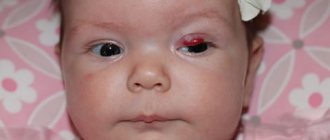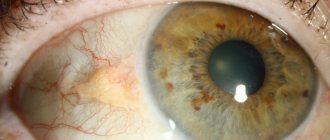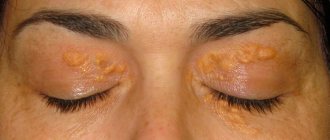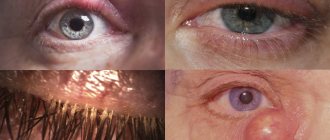Eye allergies are inflammation caused by external irritants-allergens.
In children, as in adults , allergic reactions in the area around the eyes and on the mucous membrane manifest themselves in approximately the same way , but can have more serious consequences and are observed more often.
This is due not only to weaker immunity, but also to non-compliance with hygiene rules, if they are violated, allergens get into the eyes along with dirt.
Swelling of the eyelids due to allergies: origin
The origin of allergic swelling of the eyelids depends on the specific cause.
External origin - when the mucous membrane of the eye comes into contact with an irritant. As a rule, swelling of only the eye in contact with the allergen is observed; the swelling does not spread widely. The reaction upon contact with an allergen occurs very quickly - from 5 minutes to half an hour.
Internal origin - here we are talking about a general reaction to an allergen that enters directly into the body as a result of food or airborne intoxication.
A harbinger of future swelling is often headache, weakness and loss of strength.
Treatment
After confirmation of the allergy, the patient must completely exclude contact with the irritant. To alleviate his condition, he is prescribed antihistamines. Brewer's yeast has proven itself well.
The main recommendations of doctors when confirming allergies around the eyes are as follows:
- refuse decorative eye cosmetics;
- do eye exercises;
- give your eyes a rest when working at the computer;
- ventilate the room;
- wear sunglasses;
- pay enough attention to sleep.
To support eye health, the patient is prescribed multivitamin supplements. If conjunctivitis is added to allergies around the eyes, drops are needed.
For severe rashes accompanied by severe itching, the patient is prescribed hormonal medications. Apply them in a thin layer. The course of treatment cannot be long-term, since they have many side effects. Sometimes antibiotics are also required.
Eczema under the eyes is treated with ointments based on boric acid or hydrocortisone. They are applied after washing. Inflammation of the eyelids disappears as a result of the use of preparations containing zinc.
Since allergies around the eyes are also characterized by dry cornea, the patient is prescribed drops that eliminate blockage of the tear glands, resulting in reduced swelling.
Source of allergy: diet
Children experience allergies to a wide variety of foods they eat. This is due both to the individual characteristics of a growing organism and to the properties of a number of products themselves that have varying degrees of allergenicity.
The most allergenic are citrus fruits, animal proteins and legumes, as well as chocolate, nuts and some grains.
If you have a food allergy, swelling of the eyelids is almost guaranteed. It is important to know: fermented milk products, cabbage, zucchini and broccoli, and turkey meat rarely provoke allergies.
Allergies in infants
A breastfed baby may experience allergies when the nursing mother takes certain medications (for example, antibiotics). A similar situation is observed in the case of consumption of products whose allergens are transmitted through milk to the child. Another potentially dangerous situation from an allergy point of view is the incorrect introduction of complementary foods, including failure to meet deadlines, and incorrect combination of foods.
Another circumstance that can provoke allergic swelling of the eyelids is children's hygiene. Washing powder, care products (creams, bathing gels and shampoos), certain clothing materials, and insufficient body cleanliness pose a potential threat.
Manifestations
The negative effects of allergens can manifest themselves in the form of allergic conjunctivitis. It is accompanied by inflammation of the mucous membrane of the eye.
Signs of allergic conjunctivitis:
- redness, swelling, puffiness of the eyes,
- lacrimation,
- itching and burning,
- photophobia,
- purulent discharge.
In some cases, allergies cause angioedema (angioedema). The eyelids swell extremely strongly; in general, the swelling can affect a significant part of the face. It is important to note that such swelling is not accompanied by pain, but can complicate the breathing process and, therefore, cause hypoxia and loss of consciousness.
Allergy to the eyes
The article was prepared by a specialist for informational purposes only. We urge you not to self-medicate. When the first symptoms appear, consult a doctor.
Content:
Eye allergy symptoms
Symptoms of eyelid skin allergies include:
- redness and swelling of the conjunctiva; in an advanced state, the cornea may “swim”;
- painful itching and burning;
- lacrimation and fear of light;
- feeling of discomfort.
Late referral to a specialist with this disease leads to loss of motor function of the upper eyelid. If the eyes are very watery, it is necessary to find out the presence of bacteria that have caused infection of the mucous membrane.
Causes of eye allergies
First of all, an allergy to the skin of the eyelids is a reaction of the human body to an irritating factor. The eyes are a very sensitive visual organ, so an allergic reaction is especially pronounced. Symptoms of the disease are detected in the process of damage to the conjunctiva by inflammation.
Allergies usually develop in people with weak immunity or genetic susceptibility to any allergen. As a rule, this disease occurs in combination with diseases associated with a weakened immune system.
Eye shadow - the cause of allergic reactions
Eye shadows are widely used decorative cosmetics. There is a division of shadows into types:
- dry shadows - a powdery substance obtained by pressing, containing chromium hydroxide, talc, titanium dioxide, zinc dioxide, magnesium and zinc stearates, kaolin, pearlescent and coloring pigments;
- pencil – used for quickly applying makeup, contains safe components of waxes and fatty substances;
- Creamy or liquid shadows - with a fatty base, contain ceresin and paraffin, beeswax, candle tree and wax palm wax, stearic acid and fatty substances.
Most often, allergies to the skin around the eyes occur after applying powdered eye shadow, since the smallest particles fall on the conjunctiva of the eye. A serious reason why you should stop using decorative cosmetics is individual intolerance to the components that make up the products. Of all the types of shadows listed, the use of pencils and shadows of a liquid consistency is recommended.
In this form, shedding and damage to the mucous membrane of the eyes is excluded. These are the safest products that do not contain glitter. When choosing decorative cosmetics, you must carefully study its contents. Pay special attention to pigments, these include organic compounds and minerals (metal derivatives).
Many cosmetologists claim that minerals are less dangerous than organic compounds, which are more likely to cause allergic irritation to the skin around the eyes. It should be noted that any cosmetic product, if used constantly, can provoke allergies, since allergens accumulate in the body during use. You need to know some rules regarding the safe use of cosmetics, namely:
- do not use decorative cosmetics for a long time;
- wash off makeup before bed;
- alternate using cosmetics from different manufacturers;
Types of allergies
Allergies on the eyelids are divided into types according to the type of irritant:
- Allergic conjunctivitis - redness and irritation of the mucous membrane of the eye and the skin of the eyelids;
- Vernal keratoconjunctivitis is a chronic form in adolescents under 12 years of age;
- Infectious-allergic – chronic course, provoked by a bacterial infection;
- Medicinal – occurs within a few minutes after taking a certain drug;
- Large-papillary – when the mucous membrane of the eyes is damaged by a foreign body;
- Hay fever - with intolerance to plant pollen during their flowering period;
- Chronic – stable relapses with sluggish symptoms.
These allergic reactions can be acute or chronic. They can appear all year round or be seasonal. In many cases, the cause of allergic reactions on the eyelids is poor quality cosmetics or those containing substances that cause allergies.
Diagnosis of the disease
Treatment of eye allergies is recommended only under the supervision of a specialist after diagnosis, including visual examination of the affected areas and laboratory tests. The diagnostic complex depends on the stage of the disease. Usually, a urine and blood test is prescribed; in case of severe symptoms, the results of a bacteriological and cytological examination of the mucous membrane of the visual organ may be additionally needed. During the recovery period, most allergists recommend performing a sublingual, conjunctival and nasal skin test of a provocative nature. This method allows you to identify the type of allergen and prevent allergic reactions in the future.
Treatment of eye allergies
Therapeutic procedures for allergies to the skin around the eyes are no different from the treatment of other allergic reactions. First of all, after diagnosing and determining the reasons that caused the allergy, it is necessary to stop using decorative cosmetics with the substance that caused the reaction for the duration of treatment. With the help of antihistamines, you can get rid of the symptoms of the disease that arose against the background of an irritant.
For severe allergies, doctors often resort to treatment with hormonal drugs and antibiotics. During research, as a rule, substances such as phospholipids, protein molecules and polysaccharides are found as allergens present in cosmetics. When choosing cosmetics, it is recommended to undergo testing through sensitivity tests. This will prevent problems associated with allergies arising from the action of harmful components.
Author of the article: Marina Vitalievna Degtyareva, ophthalmologist, ophthalmologist
We begin treatment
To determine the cause of the allergy, it is necessary to show the child to a specialist and undergo a series of tests, and then, in accordance with the prescription, begin medication or other treatment.
But you can also take some non-medical measures to combat swelling aimed at eliminating the allergen. You need to understand: the longer the swelling on the eyelid is present, the more the child wants to scratch it, thereby injuring the organ of vision, which can become infected.
If there is a clear understanding that allergic swelling of the eyelids is observed, the child should be protected from allergens. It is important to protect the mucous membranes of the nasopharynx and eyes from contact. For example, during the flowering season of poplar, ragweed and other allergy-hazardous plants, it is necessary to get into the habit of wearing a medical mask every day outside and frequently washing your eyes and nose. In the summer, wear sunglasses and avoid long-term exposure to the sun, and in the winter, in the cold. Clean the house frequently to combat dust. Avoid contact with animals. And of course, reconsider the food system. To speed up the process of removing the allergen from the body, give your child plenty of fluids (water should be at room temperature).
Causes of allergies around the eyes
The eyes are most susceptible to the negative effects of natural factors. They come into direct contact with dust, fur, mold, pollen and other allergens present in the air. The skin in the eye area is very thin and reacts more sharply to irritants. Under the influence of allergens, it begins to turn red. In addition, peeling and swelling of the eyelids is observed. Patients note excessive discharge from the eyes, sometimes mixed with pus.
Allergies under the eyes can occur periodically or be year-round.
In the latter case, this reaction is explained by constant exposure to an allergen (for example, wool or mold). The condition also occurs with a genetic predisposition.
Allergies around the eyes are caused by excessive sensitivity to food, cosmetics, pollen, and perfumes. Other reasons for this reaction are:
- poor nutrition;
- subcutaneous mite parasitism;
- sun exposure;
- dysbacteriosis;
- foreign bodies in the eye;
- problems with the digestive system;
- dysfunction of the thyroid gland.
Tap water and cosmetics can also cause allergic rashes near the eyes.
This condition is called eczema around the eyes . It occurs most often with weakened immunity and poor metabolism. Patients with this diagnosis are recommended to remove makeup only with hypoallergenic toners.
Redness around the eyes is not always a sign of an allergy. Sometimes this is caused by insect bites, wearing lenses, working at a computer, or infection.
Allergies and itching around the eyes accompany a condition known as rosacea . It occurs with excessive consumption of spicy foods and alcohol, as well as exposure to sunlight.
Sudden changes in temperature provoke the disease. During therapy, the patient should limit exposure to external factors on the organ of vision.
Rosacea
Eczema around the eyes in an adult
Allergies around the eyes to cosmetics
Of all cosmetics, mascara and dry eye shadow have the greatest negative effect on the eyes.
The latter remedy often gets on the cornea, causing irritation and dermatitis under the eyes. To prevent this, it is recommended to use wet shadows or a pencil.
Of the components that can cause allergies near the eyes, the following can be added to pencil and mascara:
- PEG-6. Often found in a pencil. Thanks to this component, the product acquires a soft texture.
- Silicone.
Used against hardening. Methylparaben and propylparaben. Used as a preservative. - Titanium dioxide. It is a pigment that absorbs ultraviolet radiation. Often present in eye shadow and cosmetics with sunscreen effect. An allergy occurs when the product contains too much of it.
- Aluminum powder. Also a pigment.
Inflammation under the eye is also caused by the following components present in the shadows: kaolin, tocopherol acetate, zinc oxide.
If these ingredients are present in a cosmetic product in small quantities, allergies under the eyes are rarely detected.
Dermatitis under the eyes
Allergies around the eyes due to infection
An allergic reaction around the eyes may occur due to untreated rhinitis. From…
Eye drops
The decision to use any medications in the treatment of allergies in a child should be balanced and meaningful, based on the recommendations of specialists.
Moisturizing. The most accessible and simplest of all the variety of means that can be used. They moisten the surface of the eye, wash away the allergen, and help get rid of dryness and redness of the eyeball. They are considered relatively harmless when used over a long period of time.
Decongestants. They constrict blood vessels, thereby reducing irritation. It is not recommended to use them for more than 3 days, since long-term use, on the contrary, will lead to the progression of the symptom that was initially fought - the redness will not only not go away, but will also persist for a long time.
Anti-inflammatory. Often prescribed specifically for the treatment of non-infectious conjunctivitis. Helps reduce irritation and swelling caused by allergies. They have a quick but transient effect, and therefore a course of treatment is typical for drugs of this kind.
Hormonal. They have a certain effect and help relieve allergy symptoms that appear on the eyelid. But in case of long-term use, observation by an ophthalmologist is necessary, since there is a risk of detecting side effects such as glaucoma and cataracts.
Causes
Allergy is a response, inadequate danger, reaction of the body to external stimuli. The immune system perceives it as a hostile component and begins to fight it. What the manifestations will be depends individually on each child and on his characteristics.
There are many factors that can cause allergies in children's eyes. The main ones are those that come into direct contact with the mucous membrane:
- pollen of various plants during flowering;
- household dust and mites contained in it;
- volatile particles of household chemicals;
- tobacco smoke;
- animal hair;
- infections and bacteria;
- components of medications (eye drops and ointments, etc.);
- mold fungi.
Tobacco smoke is the strongest allergen
In addition to the reasons listed, allergies in a child’s eyes can occur after prolonged exposure to cold or open sun. External physical influences that can cause an undesirable reaction include:
- various eye injuries;
- children's cosmetics applied directly to the face (for example, cream);
- surgical intervention;
- contact lenses, as well as solution for their care.
We will separately highlight food products, infant formula, etc. All this can cause a reaction not only in the eyes, but also in other parts of the child’s body. The risk especially increases if one of the parents is allergic to something.
Allergies in front of a child's eyes can occur at any age, even in newborns.
A reliable antibiotic from the fluoroquinolone group for topical use - instructions for use of Tsipromed eye drops.
In August-September, itching and watery eyes can be caused by the ragweed plant.
Antibacterial agent for local use in ophthalmology! – Read the instructions for Cipropharm eye drops at the link.
Pills
They are prescribed by a specialist based on the child’s age and the severity of his allergies after assessing how serious the allergic swelling of the eyelids is.
In pharmacies you can find many types of tablets that can relieve mild allergy symptoms. If the allergic reaction seriously threatens life, you will have to use hormonal drugs aimed at reducing inflammation and swelling.
Additionally, sorbents can be taken along with medications: they absorb toxic substances and allergens and help remove them from the body.
Sorbents for children should be easy to use, safe for the gastrointestinal tract, have no third-party additives, demonstrate high efficiency and be completely eliminated from the body. Use must be carried out in strict accordance with the instructions, observing, among other things, the dosage and duration of administration. In this case, it will be possible to achieve the effect and avoid side effects.
Treatment of allergies around the eyes
First you need to identify the allergen, then try to eliminate it.
If these are cosmetics or medications, then it is enough to stop using them and stop the course of allergies around the eyes with the help of antihistamines, and then try to avoid their repeated use. If the manifestations of allergies are very severe, then the doctor may prescribe hormonal medications to relieve the itching, and if a bacterial infection occurs, then antibiotics are also indicated.
Antihistamines for oral administration:
- Cetirizine - 1 tablet 1 time per day, Price 40-60 rubles, drops for oral administration 240 rubles.
- Chloropyramine - injections.
Price 80 rub. for 5 ampoules - Cetrin – 1 tablet. per day, with a mild course it is possible every other day. Price 150-160 rub.
- Tavegil - and in the table.
and in ampoules, price 150 -180... RECOMMENDED VIDEO FOR VIEWING:
Folk remedies
The variety of medications and their side effects creates mistrust and wariness among many. People see folk remedies as a replacement for pharmaceutical products. The experience of using such products dates back centuries, and the list of problems they are aimed at solving is wide and includes the fight against allergy symptoms.
A compress of loose leaf tea (tea bags) can provide some relief for a child experiencing swelling of the eyelids. The compress is made for each eye with a separate cotton pad after cooling the brewed tea. A similar procedure is performed with brewed chamomile - this plant fights inflammation, disinfects, soothes the skin and nourishes it with beneficial microelements.
A compress of lemon balm leaves will help relieve swelling and the accompanying itching.
But if you decide, in accordance with other popular advice, to wash your child’s swollen eyes with a solution of potassium permanganate, then there is a very high chance of getting a chemical burn to the cornea. A specialist recommendation is required.










